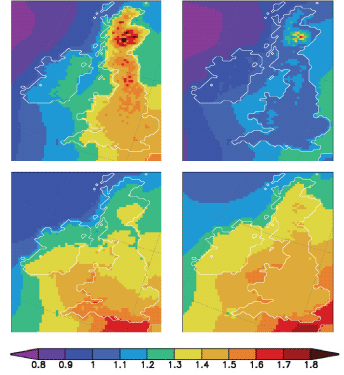Weather forecasting has always had an insatiable appetite for computer resources, driven by a need to improve the realism of numerical models by refining computational Grids or expanding the breadth of physical processes handled by the models. However, scientific aspirations are inevitably tempered by economic reality. For example, Met Éireann, the Irish National Weather Service, launched its operational numerical weather prediction system many years ago by purchasing a very modest supercomputer to support the service. The hardware quickly became dated, and while replacement systems followed every few years, economic restrictions ensured that they never quite matched the cutting-edge status of the original number cruncher. Membership of the European Centre for Medium-Range Weather Forecasting (ECMWF) did eventually bring us back into the supercomputer user club, but only for weather and climate research; for operational forecasting the policy was to depend on in-house systems that were the equivalent of powerful workstations. The issue of climate change overturned this policy.
In 2003 a regional climate modelling project was set up in Met Éireann and it quickly became clear that climate modelling, the 'big brother' of weather forecasting, would require substantial computer resources if the project were to be successful. ECMWF's high-performance computing facilities were available through national allocation or Special Project status but allotted quotas were quickly used up. Fortunately, another source of computing power arrived in 2005: the Irish Centre for High-End Computing (ICHEC), a national supercomputer centre set up to support Irish researchers. In spite of its relative newness, ICHEC quickly established itself as a reliable resource with excellent support staff. A considerable amount of climate modelling and model development work was carried out on its computers.
This experience prompted Met Éireann to examine its operational computer needs, and eventually led to scientific collaboration with ICHEC in the areas of weather forecasting and climate modelling. As part of this collaboration ICHEC provides computational facilities and support to Met Éireann to enable it to run its operational forecast models. Initially, there were doubts as to whether this collaboration could succeed; Met Éireann's operational production system has stringent delivery and reliability requirements. Eventually, all concerns were addressed in a detailed servicelevel agreement that precisely defines the responsibilities of the partners.

For Met Éireann there are obvious benefits in the collaboration: it provides access to supercomputing resources without having to purchase a dedicated computer or provide infrastructural support systems; it also provides a development path for the operational forecasting system in line with ICHEC's future plans. Strategically, the arrangement is an efficient use of national resources and, in a very small but satisfying way (given our involvement with climate change issues) it helps to reduce the Irish nation's carbon footprint. To date the collaboration has been very successful.
A big attraction for both sides was the emphasis not only on service provision but on scientific collaboration. ICHEC now joins Met Éireann in contributing to the international HIRLAM (HIgh Resolution Limited Area Model) project, which is dedicated to the development of a new state-of-the-art numerical short-range weather forecasting system for operational use. The large computing facilities available through ICHEC greatly facilitate model development, as extensive resources are required for realistic testing and debugging of the complex code. ICHEC expertise is also invaluable in optimizing the performance of the model on distributed computer systems.
The collaboration also expands Ireland's involvement in climate research, particularly in the climate modelling area. In late 2004 Met Éireann became a partner in the international ENSEMBLES project, a project funded by the European Union under the 6th Framework Programme to assess the future impacts of climate change over Europe. Simulations of the future European climate have been carried out using ICHEC and ECMWF resources. In 2007 Met Éireann and ICHEC became partners in the EC-EARTH project, an international effort to develop a new European Earth System Model based on a global coupled atmosphere-ocean system, with dynamic vegetation, atmospheric chemistry, carbon cycle and ocean biogeochemistry components. Climate simulations with this model will be run at ICHEC.
Links:
http://www.met.ie
http://www.ichec.ie/
http://ensembles-eu.metoffice.com/
Please contact:
Ray Mc Grath
Head, R&A Division Met Eireann, Ireland
Tel: +353 1 8065 520
E-mail: ray.mcgrath![]() met.ie
met.ie










